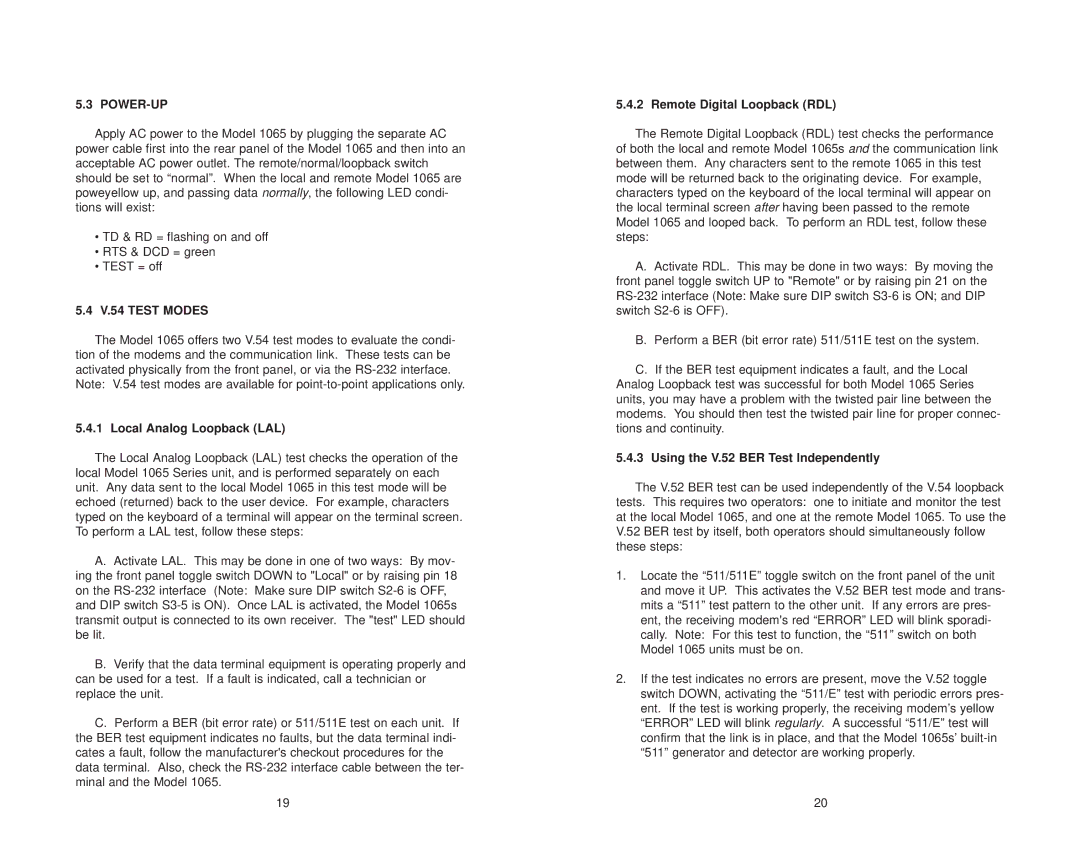5.3 POWER-UP
Apply AC power to the Model 1065 by plugging the separate AC
power cable first into the rear panel of the Model 1065 and then into an acceptable AC power outlet. The remote/normal/loopback switch should be set to “normal”. When the local and remote Model 1065 are poweyellow up, and passing data normally, the following LED condi- tions will exist:
•TD & RD = flashing on and off
•RTS & DCD = green
•TEST = off
5.4V.54 TEST MODES
The Model 1065 offers two V.54 test modes to evaluate the condi- tion of the modems and the communication link. These tests can be activated physically from the front panel, or via the
Note: V.54 test modes are available for
5.4.1 Local Analog Loopback (LAL)
The Local Analog Loopback (LAL) test checks the operation of the local Model 1065 Series unit, and is performed separately on each unit. Any data sent to the local Model 1065 in this test mode will be echoed (returned) back to the user device. For example, characters typed on the keyboard of a terminal will appear on the terminal screen. To perform a LAL test, follow these steps:
A.Activate LAL. This may be done in one of two ways: By mov- ing the front panel toggle switch DOWN to "Local" or by raising pin 18 on the
B.Verify that the data terminal equipment is operating properly and can be used for a test. If a fault is indicated, call a technician or replace the unit.
C.Perform a BER (bit error rate) or 511/511E test on each unit. If the BER test equipment indicates no faults, but the data terminal indi- cates a fault, follow the manufacturer's checkout procedures for the data terminal. Also, check the
19
5.4.2 Remote Digital Loopback (RDL)
The Remote Digital Loopback (RDL) test checks the performance of both the local and remote Model 1065s and the communication link between them. Any characters sent to the remote 1065 in this test mode will be returned back to the originating device. For example, characters typed on the keyboard of the local terminal will appear on the local terminal screen after having been passed to the remote Model 1065 and looped back. To perform an RDL test, follow these steps:
A.Activate RDL. This may be done in two ways: By moving the front panel toggle switch UP to "Remote" or by raising pin 21 on the
B.Perform a BER (bit error rate) 511/511E test on the system.
C.If the BER test equipment indicates a fault, and the Local Analog Loopback test was successful for both Model 1065 Series units, you may have a problem with the twisted pair line between the modems. You should then test the twisted pair line for proper connec- tions and continuity.
5.4.3Using the V.52 BER Test Independently
The V.52 BER test can be used independently of the V.54 loopback tests. This requires two operators: one to initiate and monitor the test at the local Model 1065, and one at the remote Model 1065. To use the V.52 BER test by itself, both operators should simultaneously follow these steps:
1.Locate the “511/511E” toggle switch on the front panel of the unit and move it UP. This activates the V.52 BER test mode and trans- mits a “511” test pattern to the other unit. If any errors are pres- ent, the receiving modem's red “ERROR” LED will blink sporadi- cally. Note: For this test to function, the “511” switch on both Model 1065 units must be on.
2.If the test indicates no errors are present, move the V.52 toggle switch DOWN, activating the “511/E” test with periodic errors pres- ent. If the test is working properly, the receiving modem’s yellow “ERROR” LED will blink regularly. A successful “511/E” test will confirm that the link is in place, and that the Model 1065s’
20
